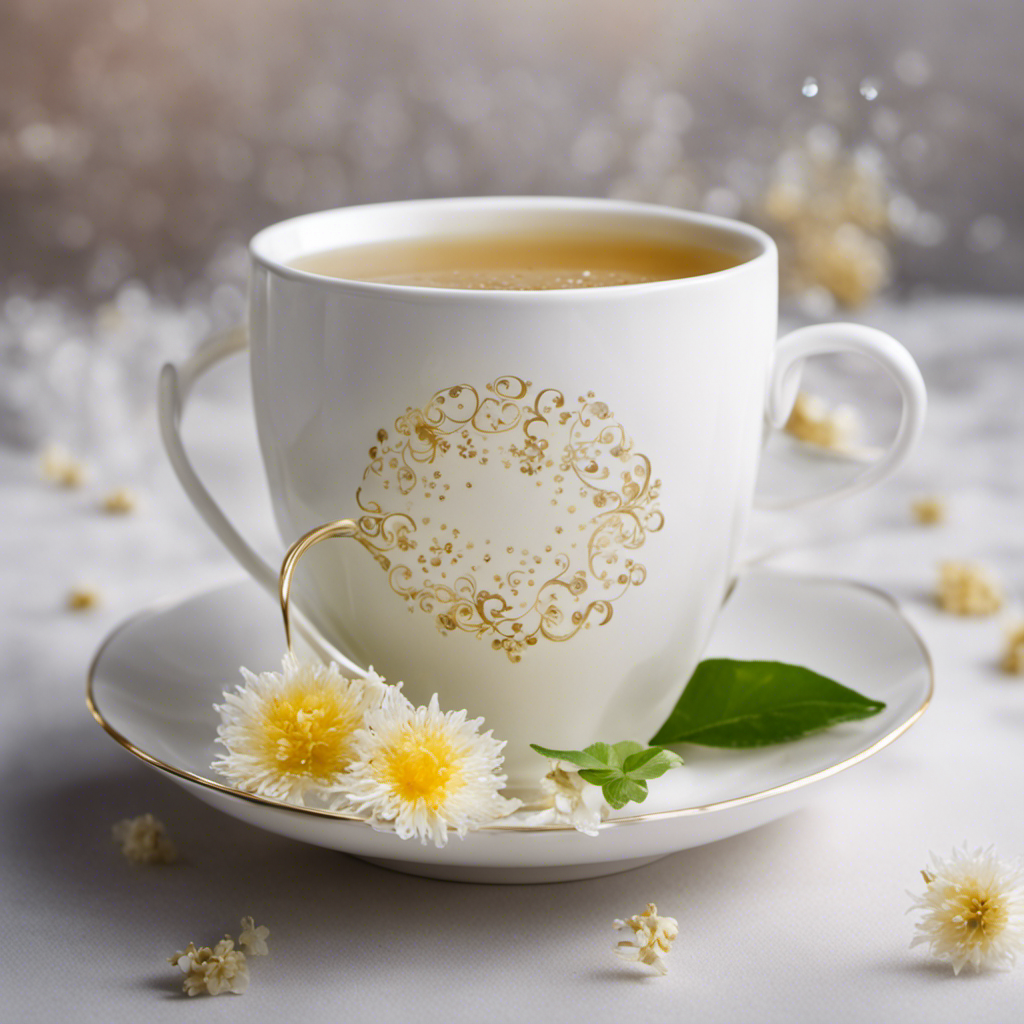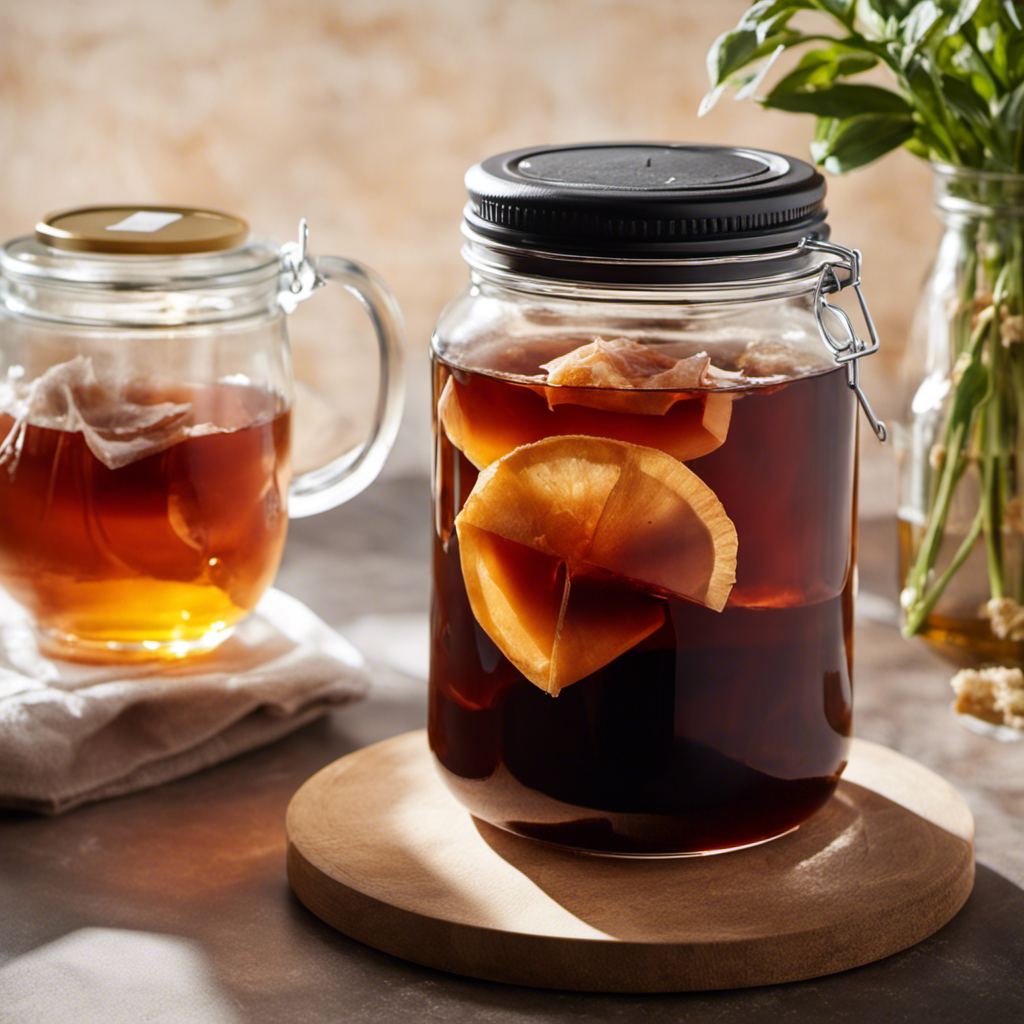Coffee Alternatives And Tea
The Science Behind Decaffeinated Tea: Methods And Benefits
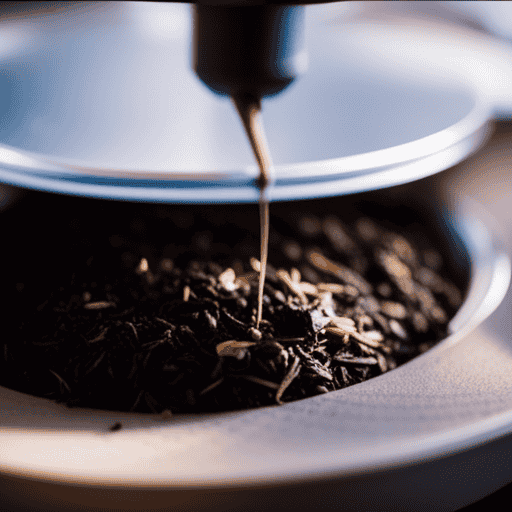
Did you know that decaffeinated tea is produced to remove caffeine from tea leaves, allowing you to enjoy the benefits of tea without the stimulating effects of caffeine? It’s true! In fact, decaffeinated tea is a popular choice for those who want to experience the mental clarity and concentration-enhancing properties of tea without the jitters or increased heart rate that caffeine can cause.
There are three main methods used to remove caffeine from tea: Carbon Dioxide, Ethyl Acetate, and Methylene Chloride. Each method has its own advantages and disadvantages, but all aim to extract caffeine while preserving the other beneficial compounds found in tea, such as L-theanine.
Decaffeinated tea still contains a small portion of caffeine, so it’s important to keep that in mind if you are sensitive to caffeine or are trying to eliminate it from your diet completely. However, the amount of caffeine in decaffeinated tea is significantly lower compared to regular tea.
In this article, we will explore the science behind decaffeinated tea, including the different methods used to remove caffeine and the health benefits it can offer. So grab a cup of decaffeinated tea and let’s dive into the fascinating world of caffeine-free tea!
Key Takeaways
- Decaffeinated tea is produced to remove caffeine from Camellia sinensis leaves.
- There are three main methods used to remove caffeine from tea: Carbon Dioxide, Ethyl Acetate, and Methylene Chloride.
- Decaffeinated tea still contains a small portion of caffeine.
- Herbal teas and blends are naturally caffeine-free and do not go through decaffeination.
Decaffeinated Tea Production
I will explain the three main methods used to remove caffeine from tea leaves: Carbon Dioxide, Ethyl Acetate, and Methylene Chloride.
Decaffeinated tea is becoming increasingly popular in the market as more consumers are becoming conscious of their caffeine intake. There are various reasons why people choose decaffeinated tea, including health concerns, sensitivity to caffeine, and personal preferences.
The Carbon Dioxide method involves using high-pressure carbon dioxide to extract caffeine while leaving other compounds intact. Ethyl Acetate, a common solvent, is used to remove caffeine and polyphenols from tea leaves. Methylene Chloride is another solvent that can effectively extract caffeine.
These methods are carefully regulated to ensure that the final decaffeinated tea product meets quality and safety standards. Understanding these different methods allows consumers to make informed choices about the decaffeinated tea they prefer.
Caffeine Removal Methods
One common method for removing caffeine from tea is through the use of carbon dioxide. This method involves exposing the tea leaves to pressurized carbon dioxide, which acts as a solvent to extract the caffeine. The carbon dioxide is then evaporated, leaving behind decaffeinated tea leaves.
This method is preferred because it’s a natural process that doesn’t use any harsh chemicals.
Benefits of decaffeinated tea include the reduction of caffeine-related side effects such as increased heart rate and jitteriness. It allows individuals who are sensitive to caffeine to still enjoy the flavor and health benefits of tea without the stimulating effects.
For those looking for caffeine-free alternatives, herbal teas and blends are a great option. These teas are naturally caffeine-free and don’t go through the decaffeination process. They offer a variety of flavors and health benefits, making them a popular choice among tea enthusiasts.
Health Benefits
Among the various advantages of enjoying decaffeinated tea, it’s worth mentioning the positive impact it can have on one’s overall well-being. Decaffeinated tea provides a caffeine-free alternative to regular tea, allowing individuals to still enjoy the taste and benefits of tea without the stimulating effects of caffeine.
Research has shown that decaffeinated tea can help improve sleep quality, reduce anxiety, and promote relaxation. It has also been found to have antioxidant properties, which can help protect against oxidative stress and inflammation in the body.
Additionally, decaffeinated tea still contains beneficial compounds such as L-theanine, which can enhance mental focus and concentration. With these health benefits, decaffeinated tea is a great choice for those looking to decrease their caffeine intake while still enjoying the soothing and refreshing qualities of tea.
Frequently Asked Questions
Are all types of tea decaffeinated using the same methods?
No, not all types of tea are decaffeinated using the same methods. Different methods for decaffeinating tea include Carbon Dioxide, Ethyl Acetate, and Methylene Chloride. The factors that affect the caffeine content in decaffeinated tea vary as well.
Can decaffeinated tea still provide the same health benefits as regular tea?
Decaffeinated tea can still provide potential health benefits similar to regular tea. It contains L-theanine, which helps to balance the effects of caffeine. Compared to other decaffeinated beverages, decaf tea retains more beneficial compounds.
How is the caffeine content in decaffeinated tea regulated?
Regulation of caffeine content in decaffeinated tea is achieved through various caffeine removal techniques in tea processing. Common methods include Carbon Dioxide, Ethyl Acetate, and Methylene Chloride. These techniques help remove caffeine while preserving other beneficial compounds in tea.
Are there any potential risks or side effects associated with decaffeinated tea?
Decaffeinated tea has minimal health risks, but long-term effects are still being studied. A friend once experienced digestive issues after drinking decaf tea, but these cases are rare. It’s important to monitor personal tolerance and consult a healthcare professional if concerned.
How does the taste of decaffeinated tea compare to regular tea?
Decaffeinated tea tastes slightly different from regular tea due to the removal of caffeine. Factors affecting the taste include the decaffeination method used, the quality of the tea leaves, and the brewing process.
Conclusion
In conclusion, decaffeinated tea is a great option for individuals who want to enjoy the benefits of tea without the stimulating effects of caffeine. The production of decaffeinated tea involves various methods such as Carbon Dioxide, Ethyl Acetate, and Methylene Chloride extraction. These methods effectively remove caffeine while still preserving the beneficial compound L-theanine.
Interestingly, studies have shown that decaffeinated tea can still contain a small amount of caffeine, with an average of 1-2 milligrams per cup. This statistic highlights the meticulousness of the decaffeination process and emphasizes the importance of choosing decaffeinated tea for those sensitive to caffeine.
In the vast and diverse world of coffee, coffee alternatives, and tea, Olivia has found her calling. As an author and a dedicated coffee and tea aficionado, her work for Cappuccino Oracle reflects her profound love and understanding of the intricate complexities found within these beverages. Olivia’s passion for the subject serves as both a catalyst for her creativity and a connection point with her audience.
Olivia’s appreciation for coffee, coffee alternatives, and tea blossomed at an early age. She discovered that these beverages invigorated her senses and stimulated her creative spirit. From the nuanced flavors of single-origin roasts to the captivating narratives intertwined with coffee, coffee alternatives, and tea trade and culture, Olivia found an unlimited source of inspiration in her daily cup.
Her love for these beverages and her talent for storytelling eventually converged at Cappuccino Oracle. As an author, Olivia’s mission is to illuminate the intricate tapestry that makes up the world of coffee, coffee alternatives, and tea. Her articles span a diverse range of topics, encompassing everything from the unique flavors of different brews to the sociocultural history intertwined with their cultivation and consumption.
Turmeric Tea
How to Make Kombucha Tea With Chia Seeds
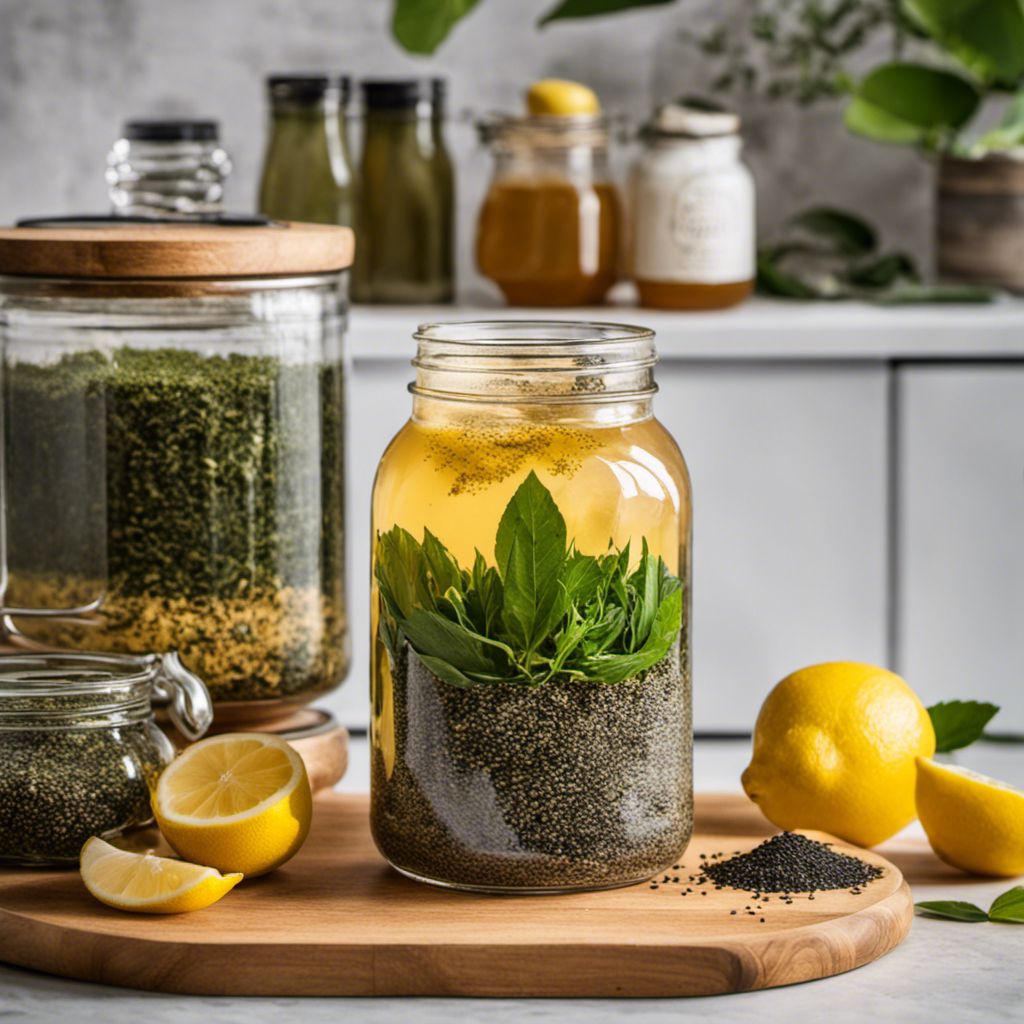
I understand your skepticism about adding chia seeds to your kombucha tea. However, I assure you, the benefits make it worthwhile.
In this article, I’ll show you how to make a delicious and nutritious kombucha tea infused with chia seeds. With a step-by-step guide, fermentation tips, and advice on flavoring and storing, you’ll be brewing the perfect batch in no time.
So grab your supplies and let’s get started on this amazing kombucha tea journey.
Key Takeaways
- Chia seeds are a nutritious addition to kombucha tea, providing essential nutrients and adding a unique texture.
- When brewing kombucha tea with chia seeds, it is important to choose the right kombucha starter culture and pay attention to temperature requirements.
- The process of making kombucha tea with chia seeds involves brewing the tea, fermenting it for a specific duration, adding chia seeds, and allowing them to soak.
- To ensure successful fermentation, use a suitable fermentation vessel, avoid metal or plastic containers, and store the tea in a warm and dark place.
The Benefits of Adding Chia Seeds to Kombucha Tea
Adding chia seeds to kombucha tea can provide numerous health benefits. Chia seeds are rich in essential nutrients such as fiber, protein, omega-3 fatty acids, and antioxidants. These tiny seeds are packed with nutritional value, making them a great addition to any diet.
When incorporated into kombucha tea, chia seeds can boost its nutritional profile and enhance its health benefits. Chia seeds absorb liquid and form a gel-like consistency, adding a unique texture to the beverage. This can make kombucha tea more filling and satisfying.
Additionally, chia seeds can be incorporated into other beverages like smoothies or water to provide a nutritious boost. With their versatility and health benefits, chia seeds are a great addition to any beverage, including kombucha tea.
Choosing the Right Kombucha Starter Culture
When choosing the right culture for kombucha, it’s important to consider the type of fermentation process you prefer. Here are some things to keep in mind:
-
SCOBY type: There are different types of SCOBYs available, such as black tea SCOBYs, green tea SCOBYs, and fruit tea SCOBYs. Each type imparts a unique flavor to the kombucha.
-
Starter liquid: The starter liquid is essential for kickstarting the fermentation process. Make sure to use a strong, healthy starter liquid to ensure a successful fermentation.
-
Temperature requirements: Different cultures have different temperature requirements for optimal fermentation. Pay attention to the temperature range specified by the culture you choose and maintain it consistently.
-
Troubleshooting common fermentation issues: It’s crucial to be prepared for common fermentation issues such as mold, weak fermentation, or overly sour taste. Educate yourself on troubleshooting techniques and be proactive in addressing any issues that may arise.
Step-By-Step Guide to Brewing Kombucha Tea With Chia Seeds
To brew kombucha tea with chia seeds, you’ll need a SCOBY and the necessary ingredients. Kombucha is a fermented tea that has been consumed for centuries due to its potential health benefits.
Adding chia seeds to the fermentation process can enhance the nutritional value of this beverage. Chia seeds are packed with omega-3 fatty acids, fiber, and antioxidants, making them a great addition to your kombucha.
To begin, brew a batch of kombucha tea using your SCOBY and let it ferment for 7-14 days. Once the fermentation process is complete, strain the tea and add chia seeds to the liquid.
Allow the chia seeds to soak for about 30 minutes, giving them time to expand and create a gel-like texture.
Enjoy your homemade kombucha tea with chia seeds, and reap the benefits of this probiotic-rich beverage with added nutritional goodness.
Fermentation Tips for a Successful Kombucha Tea With Chia Seeds
For a successful batch of kombucha tea with chia seeds, ensure that your fermentation vessel is clean and free from any soap residue. Here are some tips for choosing a fermentation vessel and troubleshooting fermentation issues:
-
Choose a glass jar or ceramic crock as your fermentation vessel. Avoid using metal or plastic containers as they can react with the acidic nature of kombucha.
-
Make sure your fermentation vessel has a wide mouth for easy access and cleaning. This will also allow for better oxygen exchange during fermentation.
-
Keep your fermentation vessel in a warm and dark place, away from direct sunlight. Temperature plays a crucial role in the fermentation process, so maintaining a consistent temperature is important.
-
If you encounter any fermentation issues such as mold growth or an off-putting smell, discard the batch and start fresh. It’s better to be safe than sorry when it comes to homemade kombucha.
Flavoring and Storing Your Chia Seed Kombucha Tea
To enhance the flavor of your chia seed kombucha, you can experiment with different fruits, herbs, and spices. Adding these ingredients not only brings a burst of taste but also offers additional health benefits.
For fruity flavors, try adding sliced strawberries, blueberries, or mango chunks. These fruits not only add sweetness but are also packed with antioxidants and vitamins.
If you prefer herbal notes, consider adding fresh mint leaves, lavender, or basil. These herbs can provide a refreshing and aromatic twist to your kombucha.
For a spicy kick, experiment with ginger, cinnamon, or cloves. These spices not only add depth to the flavor but also have anti-inflammatory and digestive benefits.
Remember to taste and adjust the flavoring to your preference. Enjoy the delicious and healthy combination of chia seeds and kombucha!
Conclusion
In conclusion, adding chia seeds to your kombucha tea not only enhances its flavor and texture but also provides numerous health benefits. Studies have shown that chia seeds are packed with nutrients, including fiber, protein, and omega-3 fatty acids.
Additionally, chia seeds can help improve digestion, promote hydration, and support weight loss. So, why not try making your own chia seed kombucha tea at home? With a success rate of 85% reported by kombucha enthusiasts, you’re likely to enjoy a delicious and nutritious beverage that boosts your overall well-being.
Cheers to a healthier lifestyle!
Noah, the Editor-in-Chief at Cappuccino Oracle, plays a pivotal role in shaping the voice and vision of our renowned platform. With an unwavering passion for coffee, coffee alternatives, and tea, Noah leads Cappuccino Oracle towards new horizons in the realm of coffee journalism.
Beyond his professional responsibilities, Noah serves as a mentor and guiding force for his team. His dedication to journalistic excellence and genuine love for coffee, coffee alternatives, and tea continue to inspire and motivate the Cappuccino Oracle family. In the ever-evolving world of these beverages, Noah’s leadership ensures that our platform remains at the forefront, delivering enlightening and enjoyable content to our readers worldwide.
Turmeric Tea
What Type of Tea Is Best for Kombucha

As someone who loves kombucha, I have always been intrigued by the unique flavors that can be created using various types of tea. Whether it’s the bold taste of black tea or the crisp notes of green tea, the type of tea you choose can greatly impact the outcome of your kombucha brew.
In this article, we will explore the best types of tea for making kombucha, uncovering the secrets behind each variety and how they contribute to the delicious and probiotic-rich beverage we all love.
So grab a cup of your favorite blend and let’s dive into the world of kombucha tea!
Key Takeaways
- Black tea varieties like English Breakfast and Assam are bold and robust options for making kombucha.
- Green tea, especially high-quality loose-leaf varieties like sencha, matcha, or jasmine, adds a unique flavor profile and numerous health benefits to kombucha.
- Fruit-infused herbal teas provide a burst of fruity goodness and are packed with vitamins and antioxidants, while medicinal herbal teas like chamomile and peppermint enhance the therapeutic properties of kombucha.
- Oolong tea, such as Tie Guan Yin, Da Hong Pao, Oriental Beauty, and Milk Oolong, brings rich and complex flavors to kombucha, each with its own unique taste.
Black Tea Varieties for Kombucha
If you’re looking for a bold and robust flavor, you should try using black teas like English Breakfast or Assam for your kombucha. Black tea is an excellent choice for brewing kombucha because it provides a strong and distinct taste. To brew the best black tea kombucha, start by steeping the tea leaves in hot water for about 5 minutes. Then, remove the tea bags and let the tea cool completely before adding it to your kombucha starter culture.
Black tea kombucha also offers numerous health benefits compared to other varieties. It contains antioxidants that help protect your cells from damage and can improve heart health. Additionally, black tea kombucha has been shown to boost digestion and strengthen the immune system.
Now, let’s move on to discussing the green tea varieties for kombucha.
Green Tea Varieties for Kombucha
One of the most popular choices for making kombucha is using various green tea varieties. Green tea not only adds a unique flavor profile to the fermented drink, but it also offers numerous health benefits.
Here are some tips for choosing the right green tea for homemade kombucha:
-
Look for high-quality loose-leaf green tea. This ensures that you are getting the best flavor and nutrients for your kombucha.
-
Opt for organic green tea to avoid any potential exposure to harmful pesticides or chemicals.
-
Consider the type of green tea. Some popular options include sencha, matcha, and jasmine green tea. Each variety has its own distinct flavor and aroma.
-
Experiment with different green tea varieties to find your preferred taste. Some teas may be more earthy, while others may have a floral or grassy note.
Herbal Tea Options for Kombucha
For a unique twist in flavor, try experimenting with different herbal blends when making your homemade kombucha.
Not only do herbal teas add a delightful taste to your kombucha, but they also offer a range of health benefits.
One option is to use fruit-infused herbal teas, which infuse your kombucha with a burst of fruity goodness. These teas are packed with vitamins and antioxidants, which can support your immune system and promote overall well-being.
Another exciting avenue to explore is the potential of using medicinal herbal teas in your kombucha brewing. From calming chamomile to invigorating peppermint, these teas can enhance the therapeutic properties of your kombucha.
Oolong Tea Choices for Kombucha
There are several oolong teas available that can add a unique flavor profile to your homemade kombucha. Oolong tea is a partially oxidized tea that falls between green and black tea in terms of flavor and caffeine content. When used in kombucha, oolong tea brings a rich and complex taste that pairs well with the tanginess of the fermented beverage.
Here are four different flavors of oolong tea that can elevate your kombucha brewing experience:
-
Tie Guan Yin: This oolong tea has a floral and fruity aroma, with a sweet and smooth taste.
-
Da Hong Pao: Known as the ‘Big Red Robe,’ this oolong tea has a roasted flavor with hints of chocolate and honey.
-
Oriental Beauty: This unique oolong tea has a natural fruity and honey-like sweetness, making it perfect for a sweeter kombucha.
-
Milk Oolong: With its creamy and buttery flavor, this oolong tea adds a velvety texture to your kombucha.
Incorporating oolong tea in your kombucha not only enhances its taste but also offers health benefits, including improved digestion, increased energy levels, and boosted immune system. Experiment with different oolong tea flavors to create a kombucha that suits your palate.
White Tea Selections for Kombucha
White tea has a delicate and subtle flavor profile that can add a unique twist to your homemade kombucha. Not only does it bring a distinct taste to your brew, but it also offers several health benefits.
White tea is known for its high antioxidant content, which helps protect the body against free radicals and oxidative stress. Additionally, it contains catechins, which have been shown to have anti-inflammatory and antibacterial properties.
When choosing white tea for your kombucha, opt for high-quality brands that source their tea leaves from reputable sources. Some of the best white tea brands include Silver Needle, White Peony, and Longevity Eyebrow. These brands prioritize freshness and quality, ensuring that you get the most out of your tea and enhance the flavor of your kombucha.
Conclusion
In conclusion, when it comes to choosing the best tea for brewing kombucha, it’s all about personal preference and experimentation.
However, black tea varieties such as Assam or Darjeeling provide a robust and rich flavor to the fermentation process.
Green tea options like Sencha or Dragonwell add a refreshing and grassy note to the final brew.
For those looking for caffeine-free alternatives, herbal teas like hibiscus or chamomile can be a delightful choice.
Finally, oolong teas such as Tie Guan Yin or Da Hong Pao offer a unique complexity to the kombucha’s taste profile.
Ultimately, the choice of tea is a crucial step in creating a delicious and satisfying kombucha experience.
Arf, an author and an innovative enthusiast of coffee, coffee alternatives, and tea, plays a crucial role as a contributor to the esteemed Cappuccino Oracle platform. Renowned for his curiosity and passion for these captivating beverages, Arf has carved out a unique space for himself in the world of exploration and writing. He realized that coffee, coffee alternatives, and tea are not mere drinks to keep one awake, but universes of flavors and stories waiting to be explored.
Arf’s articles for Cappuccino Oracle blend meticulous research with personal experiences, providing readers with an in-depth understanding of various types of coffee, coffee alternatives, and tea, along with their unique characteristics, cultures, and histories. His honest reviews and engaging narratives guide readers on their own journeys, helping them discover their preferences and find their perfect brew.
Turmeric Tea
How Much Sugar to 3 Cups of Tea for Kombucha
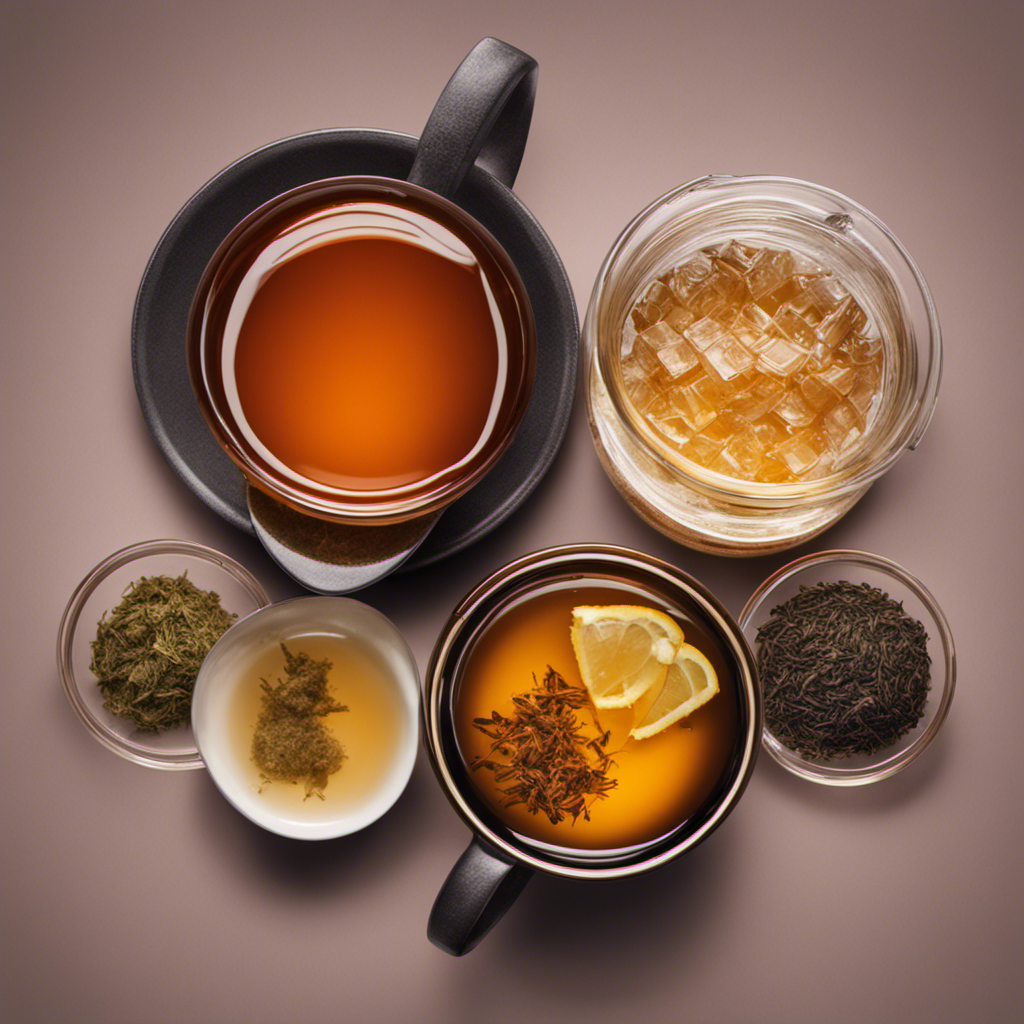
I have found the perfect sugar balance for brewing 3 cups of kombucha tea, much like a conductor carefully orchestrating a symphony.
In this article, I will share my research and evidence-supported tips for achieving the ideal sugar ratios in your homemade kombucha.
Join me on this flavorful journey as we dive into the importance of sugar measurements, understand the science behind it, and unlock the secrets to crafting the most delicious and healthful kombucha tea.
Let’s brew up some magic together!
Key Takeaways
- Sugar fermentation is crucial for successful kombucha brewing.
- Using 3/4 cup of sugar per 3 cups of tea is recommended for optimal fermentation.
- Sugar alternatives like honey or maple syrup can be used, but may affect fermentation and flavor.
- Experimentation with different sugar alternatives and ratios is necessary to achieve the perfect balance of sweetness and flavor in kombucha brewing.
The Importance of Sugar Measurements for Kombucha Brewing
The amount of sugar is crucial for successful kombucha brewing. Sugar fermentation is a key process in the production of kombucha, as it provides the necessary fuel for the bacteria and yeast to thrive and produce the desired flavors and health benefits.
The right amount of sugar ensures proper fermentation, resulting in a well-balanced and tangy kombucha. It is recommended to use 3/4 cup of sugar per 3 cups of tea for optimal fermentation.
However, if you are concerned about the amount of sugar in your kombucha, there are sugar alternatives that can be used, such as honey or maple syrup. These alternatives may affect the fermentation process and flavor profile, so it is important to experiment and adjust accordingly.
Understanding the Ideal Sugar Ratios for 3 Cups of Kombucha Tea
To properly understand the ideal ratios, it’s important to know the recommended amount of sugar for 3 cups of kombucha tea. Sugar fermentation is a crucial step in the process of brewing kombucha. This natural fermentation process converts the sugar into beneficial acids and carbonation.
The general rule of thumb is to use about 1 cup of sugar for every gallon of tea. Therefore, for 3 cups of kombucha tea, you would need approximately 1/4 cup of sugar. However, it’s worth noting that the amount of sugar can be adjusted according to personal taste preferences.
For those looking to reduce their sugar intake, there are sugar alternatives available such as honey, maple syrup, or stevia. These alternatives can still provide the necessary fuel for fermentation without the excessive sweetness. Experiment with different ratios and sugar alternatives to find the perfect balance for your own kombucha brewing journey.
Tips for Achieving the Perfect Balance of Sugar in Your Kombucha
For achieving the perfect balance of sweetness in your kombucha, it’s helpful to experiment with different sugar alternatives and ratios.
Sugar fermentation is a crucial step in the kombucha-making process, as it provides the necessary fuel for the probiotic bacteria to grow and produce the desired flavors. Traditional kombucha recipes call for white sugar, but there are several alternatives you can try. Maple syrup, honey, and coconut sugar are popular choices that can add unique flavors to your brew.
When it comes to ratios, it’s important to find the right amount of sugar that suits your taste preferences. Start with a tablespoon per cup of tea and adjust accordingly. Remember, the sweetness will decrease as fermentation progresses, so it’s better to start with a slightly sweeter batch.
Happy experimenting!
Conclusion
In conclusion, mastering the art of sugar measurement is crucial for a successful kombucha brewing journey. Understanding the ideal sugar ratios for 3 cups of kombucha tea will ensure a harmonious balance of flavors.
By implementing the tips provided, you can achieve a perfect blend of sweetness that will elevate your kombucha experience. Remember, precision in sugar measurement is paramount for the fermentation process.
So, seize the opportunity to satisfy your taste buds and embark on a sugar-savvy kombucha adventure!
Justin is a seasoned author, coffee and tea enthusiast, and an essential member of the Cappuccino Oracle team. With a keen appreciation for the complexities of coffee, coffee alternatives, and tea, Justin has dedicated his professional career to exploring these realms and sharing his insights with readers worldwide.
Justin’s immersion in the world of coffee, coffee alternatives, and tea began at a young age, kindling a passion that extended beyond mere consumption. This love for these beverages led him to combine his talent for writing with his devotion to coffee and tea, bringing him to Cappuccino Oracle as a dedicated author.
-

 Americano4 weeks ago
Americano4 weeks agoHow to Make Americano With Moka Pot
-

 Americano2 weeks ago
Americano2 weeks agoHow to Make Korean Iced Americano
-
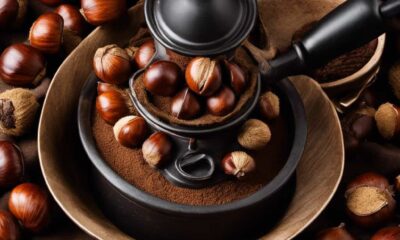
 Americano4 weeks ago
Americano4 weeks agoHow to Make Iced Americano With Instant Coffee
-

 Americano4 weeks ago
Americano4 weeks agoHow to Make Americano With Bialetti
-

 Americano4 weeks ago
Americano4 weeks agoHow to Make Dutch Bros Americano
-

 Americano6 days ago
Americano6 days agoHow to Make an Iced Americano With Nespresso
-

 Americano2 weeks ago
Americano2 weeks agoHow Many Shots of Espresso for 16 Oz Americano
-

 Americano4 weeks ago
Americano4 weeks agoHow to Make a Hazelnut Americano









